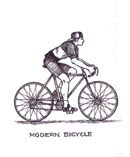HISTORY OF BICYLE IN TIMELINE:
1418
Giovanni Fontana built the first human powered land vehicle -- it had four wheels and used an endless rope connected via gears to the wheels.
1493
Sketches showing a primitive version of a bicycle, purported drawn by
Leonardo da Vinci, surfaced in 1974. Further examination of the drawings indicates these are not by da Vinci's hand. The speculation that these are a sketch by a pupil after a lost drawing by da Vinci is also considered false. An age test was performed, but the library in Milan (belonging to the Vatican) conceals its negative outcom.
1791
Comte de Sicrac is credited with building the "celerifer" - purportedly a hobby horse with two wheels instead of a rocker. This is now considered a patriotic hoax created by a French historian in 1891. It was debunked by a French researcher in 1976. In fact, a Jean Sievrac (!) of Marseille obtained an import price for a four-wheeled speed coach called celerifer in 1817.

1817
Variously called the running machine, velocipede, Draisienne and dandy horse, it was invented by Karl Drais, in response to widespread starvation and the slaughtering of horses, the consequence of a crop failure the year before (caused by the eruption of Tambora). It had a steer-able front wheel. This is the first appearance of the two-wheeler principle that is basic to cycling and motorcycling and minimizes rolling resistance. The velocipedes were made entirely of wood and needed to be balanced by directing the front wheel a bit. People then did not dare to lift the feet off safe ground, therefore the velocipedes were propelled by pushing off with the feet. After the good harvest in 1817 riding velocipedes on sidewalks was forbidden worldwide, since the velocipeders used the sidewalks, and because they could not balance on the rutted carriageway, the fad passed. It took nearly 50 years, until a roller-skating boom created a new public with a better sense of balance.
1839
Another entry in bicycle lore: Kirkpatric Mcmillan, a Scottish blacksmith adapted a treadle-type pedals to a bicycle, is considered a hoax, see the
David Herlihy's book.

1863
Bone Shaker or Velocipede: Made of stiff materials, straight angles and steel wheels make this bike literally a bone shaker to ride over the cobblestone roads of the day. The improvement is a front wheel with peddles -- direct drive, fixed gear, one speed. This machine was known as the velocipede ("fast foot"), but was popularly known as the bone shaker, They also became a fad, and indoor riding academies, similar to roller rinks, could be found in large cities.

1870
Ordinary: These are better know as the "high wheelers". It is more comfortable to ride than its predecessor, but it requires an acrobat so they popularity has always been limited. This was the first all metal machine to appeared. (Previous to this metallurgy was not advanced enough to provide metal which was strong enough to make small, light parts out of.) The pedals were still attached directly to the front wheel with no freewheeling mechanism. Solid rubber tires and the long spokes of the large front wheel provided a much smoother ride than its predecessor. The front wheels became larger and larger as makers realized that the larger the wheel, the farther you could travel with one rotation of the pedals. You would purchase a wheel as large as your leg length would allow. These bicycles enjoyed a great popularity among young men of means (they cost an average worker six month's pay), with the hey-day being the decade of the 1880's. Because the rider sat so high above the center of gravity, if the front wheel was stopped by a stone or rut in the road, or the sudden emergence of a dog, the entire apparatus rotated forward on its front axle, and the rider, with his legs trapped under the handlebars, was dropped unceremoniously on his head. Here the term "taking a header" came into being. This machine was the first one to be called a bicycle ("two wheel").
1872
Friedrich Fischer (German) first mass-produces steel ball bearings, patented by Jules Suriray in 1869.
1876
Browett and Harrison (English) patent an early caliper brake.
1878
Scott and Phillott (English) patent the first practicable epicyclic change-speed gear fitted into the hub of a front-driving bicycle.
1879
Henry J. Lawson (English) patents a rear wheel, chain-driven safety bicycle, the “Bicyclette” (his earlier models were lever driven).
1880
Thomas Humber (English) adapts the block chain for use with his range of bicycles.

1880's
While the men were risking their necks on the high wheels, ladies, confined to their long skirts and corsets, could take a spin around the park on an adult tricycle. These machines also afforded more dignity to gentlemen such as doctors and clergymen. Many mechanical innovations now associated with the automobile were originally invented for tricycles. Rack and pinion steering, the differential, and band brakes, to name a few!
1880
Bicycle Activism: Good roads society organized by bicyclist and lobbied for good roads -- paving the way for motor vehicles!
1884
Thomas Stevens struck out across the country, carrying socks, a spare shirt and a slicker that doubled as tent and bedroll. Leaving San Francisco at 8 o'clock on April 22, 1884, he traveled eastward, reaching Boston after 3700 wagon trail miles, to complete the first transcontinental bicycle ride on August 4, 1884. After a pause, he continued east, circumnavigating earth, and returning to San Francisco on Dec 24, 1886. See
Around the World by Bicycle, 2000
reenactment of 1884 ride, and 2006
reenactment of 1885 ride.
1888
Pneumatic tire: First applied to the bicycle by an Irish veterinarian who was trying to give his sickly young son a more comfortable ride on his tricycle. This inventive young doctor's name was Dunlop. Now that comfort and safety could be had in the same package, and that package was getting cheaper as manufacturing methods improved, everyone clamored to ride the bicycle.

1890
Safety Bike: As the name implies the safety bike is safer than the ordinary. The further improvement of metallurgy sparked the next innovation, or rather return to previous design. With metal that was now strong enough to make a fine chain and sprocket small and light enough for a human being to power, the next design was a return to the original configuration of two same-size wheels, only now, instead of just one wheel circumference for every pedal turn, you could, through the gear ratios, have a speed the same as the huge high-wheel. Initially, the bicycles still had the hard rubber tires, and in the absence of the long, shock-absorbing spokes, the ride they provided was much more uncomfortable than any of the high-wheel designs. Many of these bicycles of 100 years ago had front and/or rear suspensions. These designs competed with each other, your choice being the high-wheel's comfort or the safety's safety, but the next innovation tolled the death of the high-wheel design -- pneumatic tires. This is basically the same design as standard contemporary bikes. The safety bike allowed large numbers of people to take up cycling. Bikes were relatively expensive so use was somewhat restrict to the elite.
1890
Mass Production: The bicycle helped make the Gay Nineties what they were. It was a practical investment for the working man as transportation, and gave him a much greater flexibility for leisure. Women would also start riding bicycles in much larger numbers.

1894
Change In Social Order: Betty Bloomer's bloomers become very popular. Ladies, heretofore consigned to riding the heavy adult size tricycles that were only practical for taking a turn around the park, now could ride a much more versatile machine and still keep their legs covered with long skirts. The bicycle craze killed the bustle and the corset, instituted "common-sense dressing" for women and increased their mobility considerably.
Victorian women cyclists. American Music and women bicyclists.
Women and bicycles.
1894
The bicycle messenger business started in California when a railway strike halted mail delivery for the Bay Area. An ingenious bicycle shop owner in Fresno came up with the idea to deliver it by bicycle. He set up a relay between Fresno and San Francisco, with 6 riders covering about 30 miles each. The last rider would cover 60 miles.
1894-95
Annie Cohan (a.k.a. Annie Londonderry) bicycles around the world. Scant information has her leaving Boston in June 1894 on her Sterling bike and finishing her ride in Chicago in Sept 1895.
1895
Ignatz Schwinn and Adolph Arnold formed Arnold, Schwinn & Company to produce bikes.
1896
"Let me tell you what I think of bicycling. I think it has done more to emancipate women than anything else in the world. I stand and rejoice every time I see a woman ride by on a wheel. It gives woman a feeling of freedom and self-reliance." Susan B Anthony
1898
1899
1903
Internal hub gears invented by
Sturmey Archer. By 1930 these were used on bikes manufactured around the world. There dominance lasted until the 1950s the parallelogram derailleur was introduced. See also
Sturmey Archer Bicycle Hubs.
1920
Kids Bikes: The focus of planning and development of the transportation infrastructure was the private automobiles. Bicycles use declined and the bicycle was considered primarily as children's toys. Kids bikes were introduced just after the First World War by several manufacturers, such as Mead, Sears Roebuck, and Montgomery Ward, to revitalize the bike industry (Schwinn made its big splash slightly later), these designs, now called "classic", featured automobile and motorcycle elements to appeal to kids who, presumably, would rather have a motor. If ever a bike needed a motor, this was it. These bikes evolved into the most glamorous, fabulous, ostentatious, heavy designs ever. It is unbelievable today that 14-year-old kids could do the tricks that we did on these 65 pound machines! They were built into the middle 50s, by which time they had taken on design elements of jet aircraft and even rockets. By the 60s, they were becoming leaner and simpler.
1930
Tullio Campagnolo patents the quick release hub.
1930's
Schwinn introduced the fat tire, spring fork, streamline Excelsior, designed to take the abuse of teenage boys, which was the proto-type mountain bike. The Schwinn Excelsior frames became the model for the early mountain bikes almost fifty years later.
1938
Simplex introduced their cable shifted derailleur.

1950s
Tullio Campagnolo introduced cable-operated, parallelogram derailleur. Campagnolo. For two decades Campagnolo equipment dominated true racing bikes. Eventually, he acquires 135 patents.
1958
Women ride in the first-ever World Championships on the road and track. Balina Ermolaeva becomes the first women's World Sprint Champion; Elsy Jacobs takes the road race.
1962
Renaissance: President's Council of Physical Fitness. Renewed interest in bicycle for recreation and fitness. This was the seed of a new major bicycle boom that accelerated through the 60's. The "English 3-speed" was the fancy consumer model of the time. Before the end of the decade it was the 10-speed derailleur "racing bike" which dominated the American market (the derailleur had been invented before the turn of the century and had been in more-or-less common use in Europe since).
1970
Earth Day: Increased awareness of westerns civilization's level of consumption of natural resources, air pollution, and destruction of the natural environment. This generated a new spurt in the growth of bicycle sales and bicycling, especially around college campuses.
1973
Oil embargo: Fuel shortages and shifts in relative price of transportation options created an environment which encouraged bicycle commuting. Many of the new recruits to bicycling stuck to it after the end of the embargo and became enthusiasts. There was also reinvigorated interest in the engineering of bicycles, including renewed interest
recumbents and fairings.
1977
The prototype of the mountain bikes were first developed in Marin Co, California, north of San Francisco. Joe Breeze, Otis Guy, Gary Fisher, and Craig Mitchell were the earliest designers, builders and promoters.
1978
A new round of steep oil prices increases further encouraged bicycling. More bikes than car were being sold in the USA. Triple chain-ring cranks had become widely available, adding to the range of situation that bicycle were practical for.
1980's
Renewed interests in health and fitness, by the middle and upper class perpetuated the acceptance and growth of commuting, recreational and touring bicycling.
1980's
Bike messengers develop should backs to carry large envelopes flat. The style migrates into general use as an alternative to back packs, ruck sacks and purses.
1980's
Aerobic exercisers take the padding out of bike shorts and use them in exercise class. The style migrates into general use -- some wearers haven't exercised in decades.
1984
Tour de France Feminine run for the first time (winner: Marianne Martin.)
1984
Women's road race included in the Olympics for the first time (winner: Connie Carpenter.) Successes by American racing cyclist in the 1984 Olympics drew attention and added prestige to cycling. The ranks of racing cyclists grew substantially.
1984
Cogs began to be added to the rear gear cluster the number of speeds increase from 15 to 18, 21 and 24.
1984
Three-time national XC champion Jacquie Phelan founds the Women's Mountain Bike and Tea Society; the first formal outreach organization for women. WOMBATS is dedicated to introducing women to mountain biking in a fun, non-competitive environment.
1990
Shimano (Japanese) introduces integrated brake/gear levers.
1994
Sachs (SRAM) introduces PowerDisc, the first mass-produced hydraulic disc brake system.
1996
Mountain Bike compete at the Olympic Games for the first time in Atlanta, GA USA.
1986
Department of the Interior and Nielson surveys show that bicycling is the third most popular participatory sport after swimming and general exercise.
2000
Rohloff Speedhub 14 speed internal hub gearing system, with no overlapping ratios and a gear range as wide as a 27-speed derailleur system.
2002
Campagnolo introduces 10 cog rear cluster, allowing 30 speed bicycles








